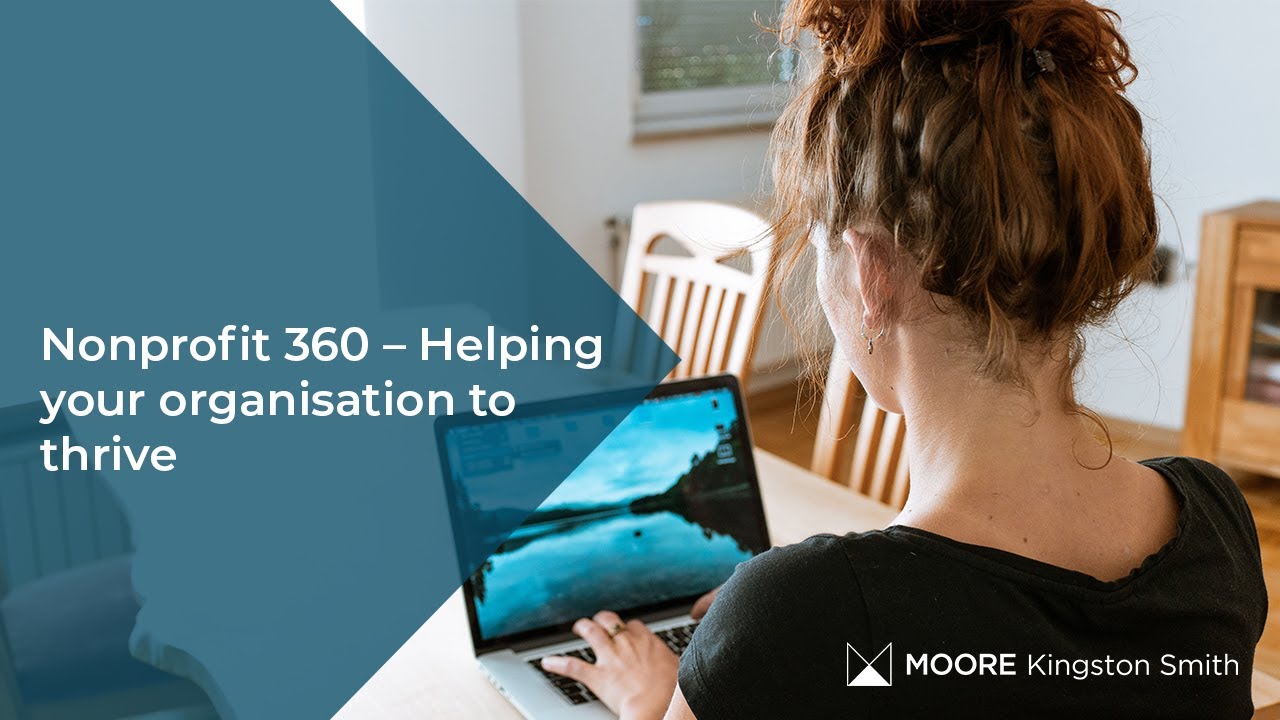Charity Workshop newsletter | October 2022
Not too long ago we were all focused on an uncertain future and just as the pandemic started to subside, we were all looking forward to getting back to ‘normal’. Well, things still seem very uncertain and, with the cost-of-living crisis and the war in Ukraine making the headlines daily, normal feels very far away.
This Charity Workshop newsletter will hopefully address some of the challenges you might be facing. We continue to send out regular alerts and hold webinars, and we have our first face-to-face event in November in our new office.
We also changed our group name to Nonprofit, relocated our head office to Liverpool Street and implemented hybrid working. These are all very positive changes for us.
Please get in touch if you would like to discuss any of the articles in more detail.
Charity strategy trends in 2022
By Dan Fletcher, Director, Moore Kingston Smith Nonprofit Advisory
Leading a charity during turbulent times is always challenging. The pandemic has demonstrated how a global emergency affects the nonprofit sector and organisations that have survived the shock demonstrate resilience and vision. However, there are more ‘bumps in the road’ to come. We are finding that charities and nonprofits are continuing to redefine their purpose and develop new, agile strategies to adapt to these future unknowns.
Despite charities and nonprofits rising costs and declining incomes, our work in recent months has seen organisations changing direction in response to the pandemic’s paradigm shifts. In many ways the rule book has been ripped up, particularly in relation to digital, inclusion, a focus on being local, and managing employees’ work-life balance.
Any social purpose-driven organisation is defined by the change it creates for those it serves. This social change should be what drives strategy and decision-making. There is, however, always a battle between delivering social value and balancing the finances.
When planning for an uncertain future, is your nonprofit impact-led or money-led?
We use several tools to help clients take stock and then imagine how their future may change. We map the social value they create against the profitability of each of their activities and ask about the relative importance of making a difference against prudent management of resources – are they impact or money-led? Our strategy tools identify if they need to maintain the status quo or have the freedom to respond to a different future. Our 360 diagnostic tool uses an MOT-like checklist to identify the warning signs of organisational weaknesses and builds ways to prevent them.
Through this work, we are seeing some interesting trends:
- Despite much deeper trustee involvement in managing charities during the pandemic, there is more work to be done to equip trustees to make decisions about investing in the future. For example, in fundraising, understanding stakeholders or measuring impact.
- Charity leaders’ abilities to collaborate effectively to achieve systemic societal change is increasingly important. Managing stakeholder expectations is more demanding, but old models of a charity single-handedly fighting a societal problem is becoming more obsolete.
- 10 or even 5-year strategic plans are rare. Nonprofits are focusing on meaningful timespans – six months to two years – with the expectation of regular re-assessments.
- Succession planning is critical with the shortage of prospective employees to fill vacant shoes at all job role levels. Charity leaders need creative solutions both for talent retention and to deconstruct unneeded silos.
- Deciding what not to do is an even more critical aspect of strategic thinking than it has been.
- Time to reflect and plan is a luxury. But it invariably more than pays for itself by enabling leaders to solve uncompromising issues and reinvigorate overstressed teams.
- Doing the right thing for inclusivity will challenge pre-existing power structures and requires deep-rooted change that can undo the core of an organisation’s mission.
Your people, your strategy
By Dan Fletcher, Director, Moore Kingston Smith Nonprofit Advisory, and Dinah Patmore, Strategic HR Partner, Moore Kingston Smith HR Consultancy
Fundraising is fundamental in many charities so having the right person in the role should not be taken lightly. Recruitment is not always easy and can take time and how do you know you have the right person before they have even started?
There are steps you can take to help you solve your recruitment challenges. Some of our solutions do not involve candidates as such.
An initial step is to consider how much the role requires a specific long-term individual, versus somebody who can complete specific tasks. The former will do the job while also accruing organisational memory relating to their function and investing in the future of the role, building the organisational significance of their work through the inter-personal connections they develop. A task-based role is just that. A specific objective needs to be achieved and additional paraphernalia of the role does not necessarily add value to the organisation.
The most straight-forward example for the Moore Kingston Smith Nonprofit Advisory team is when we provide interim management to give senior input into a charity while it recruits for a role. This can also be an opportunity to take stock of the fundraising strategy and use the time to re-evaluate who will best fill the future role. We can provide line-management support of fundraising teams during an assignment like this and can also assist in the recruitment process, advising on the job description and providing expert adviser input into the interviews.
Some organisations adopt a more creative perspective following our advice. A review of the outcomes required may show that there are a series of tasks to be undertaken. Using our pool of associates, we can outsource the solution, so that the charity does not need to invest in extra management or human resource time.
For example, we have undertaken prospect research and made approaches to grant-making trusts on behalf of clients who were unable to find a permanent trust fundraiser. Sometimes, a client needs expert support but does not want to invest in team members. For example, legacy marketing and administration is a specialist area which can be needed on a regular, but specific task-basis. As part of an outsourced package, it makes sense to secure senior input on legacy fundraising strategy in tandem with skilled input to complete more routine tasks.
A fuller outsourced option can also work well. For charities that are not primarily fundraising charities, they can buy the services of a fully functioning fundraising team but only for the time required to meet their financial targets. While there are obvious strengths to in-house fundraising teams, there are also good reasons to outsource if fundraising is not a core function, or the nonprofit is going through a transition. It may be better for a charity to invest in having the right skills at hand rather than staff with detailed experience of its inner workings.
The current job market is challenging for employers and so it pays to take creative approaches to find the best way to deliver results with the least amount of risk.
If you do decide to recruit an individual rather than outsource, having a talent acquisition strategy to attract the right candidate is crucial. There are many considerations when devising your strategy, here are just a few:
- What kind of contract will you offer? Permanent, fixed term?
- Which exact skills do you need to acquire?
- How will you source candidates?
- How will you assess these skills?
- What will your selection process be?
- How do you set yourself apart from your competitors and how/when should this be communicated?
- How will you reward the job holder? Do you need to benchmark the salary/benefits?
Some of these questions are simpler to answer than others. For example, assessing candidate skills; we know that only holding interviews means you are only just over 50% likely to choose the right candidate for the role. You are much more likely to choose a suitable candidate for the role if you combine an interview with an ability test for example.
In today’s fast-moving candidate-led market, the selection process needs to be quick and your organisation attractive, so these elements of the strategy need considerable thought. Having an effective talent acquisition strategy is more likely to provide a return on your investment in terms of time to hire, reducing unsuccessful hires, lowering employee turnover and reducing the costs of inductions and loss of productivity.
HMRC announces new policy on charities and non-business activity
By Debbie Jennings, VAT Director, and Geraint Lewis, VAT Director, Moore Kingston Smith
On 6 June 2022, HMRC announced a change in policy regarding what it believes are the tests that should be used to determine whether an activity is a business activity or a non-business activity for VAT purposes. This distinction is an important one for charities and nonprofit organisations, as they often undertake primary purpose activities that are not business for VAT purposes. This can have a direct impact on the potential amount of VAT that they may need to pay (or them needing to register for VAT in the first place) and the amount of VAT that they are entitled to recover. It can also directly impact the entitlement of a charity to qualify for VAT relief on certain types of expenditure.
Historically, HMRC policy, based on long-established case law, was that anything done for payment was a business activity, even if the level of that payment was not wholly commercial, or did no more than cover direct costs. As a result, charities have often had to account for VAT on certain charitable activities not designed or set up to generate income, and where there is no profit motive. Nevertheless, they have been seen as being a business activity for VAT.
Two-stage approach
Following several recent cases, HMRC has amended its policy such that it reflects a more complex two-step approach. This replaces the six criteria that have been used for many years to determine whether an income and associated income is related to a business activity. HMRC does not say whether the policy change will only apply from a current date, or whether it could have any retrospective impact.
The new two-stage policy requires not only that the customer is paying for the goods or services, but also that the supplier (in this case, the charity) is undertaking this activity with a view to obtaining income. That is, there is a direct link between what is provided and what is being paid in return. Also, it appears to be saying that the intention of the supplier, from the outset of the arrangements, should be taken into account. The ‘business’ test needs to be applied where goods or services are provided specifically in return for the agreed payment. The new policy requires that, where there is a direct link between the provision of the goods or services in return for a payment, this is a business activity, reflecting clear reciprocation by both parties.
Neither the courts nor HMRC have defined what obtaining income means in this context; however, it clearly means more than simply receiving funds. Also, it is interesting to note that in the brief, HMRC links this change to a profit motive being a strong indicator of a business activity. However, the absence of profit does not mean that the activity is a non-business activity. Also, the actual level of the funding is not referred to, in that the payment could be less than cost recovery and still potentially be payment within the scope of business for VAT purposes. HMRC does say that there is no definitive and clear set of criteria to be applied in their area despite the updated policy, which still means that the business test is a grey area. This development suggests that HMRC may now take the view that charities providing goods and services in return for payment that is set at or below cost, or where activities are subsidised by charitable funds, are involved in non-business activities. It appears that it will depend on the specific arrangements between the two sides.
Non-business activities result in charities often suffering a restriction on the recovery VAT on associated costs. Many charities have been able to use the very wide definition of business for VAT purposes to recover VAT on costs, especially in cases where the income qualifies for zero-rating. However, if HMRC now takes the view that a business requires a profit motive, or a similar commercial income generation motive, charities may lose a substantial amount of VAT recovery on costs.
For example, animal rescue charities have for many years been able to treat the sale of unwanted domestic animals as zero-rated business activities, thereby enabling them to recover VAT on costs.
Such charities typically do not obtain any commercial-type income from selling these animals and use charitable funds to support their day-to-day operations. If this were to become a non-business activity, such charities would lose the right to recover VAT on costs.
The potential expansion of non-business activities to include more core charitable operations may not be all bad news, as it may make it easier for charities to avoid paying VAT on certain construction costs.
The key takeaway here must be to determine from the outset what you need to do if you want an activity to be a business activity or a non-business activity. Although you may not be able to successfully achieve this, the two-stage evaluation process can provide a guide to structuring the arrangements between the two parties and reflecting the payment process. Also, when arrangements have been agreed, it is always prudent to record the key terms of that agreement in writing and to keep this as a record.
Partnerships and collaboration in the charity sector in 2022
By James Saunders, Partner, Moore Kingston Smith
For some time, commentary on charities working together has generally referred to mergers and partnerships as a topic, giving ‘equalish’ weighting to these two options. In fact, the most recent data on mergers only confirms that this phrasing is something of an inaccuracy.
Partnerships are very common in the charity sector – it is not excessive to say that any significant modern charity would expect to work in collaboration with other organisations to some extent to operate effectively and, importantly, work positively for its beneficiaries.
Mergers however remain at a very low level, with only 0.09% of charities merging in 2020/21[1] (which was an increase on previous years). There are well-documented reasons for this, notably the very personal nature and investment of people in charities compared with other types of entity.
But partnerships are flourishing more than ever, particularly because of the recent drive of the corporate and public sectors to partner with organisations which deliver social value in a more invested and strategic way.
This drive has two elements which are worth examining for charities:
‘Corporate philanthropy’ used to mean business giving money randomly and inconsistently, but the modern successful partner relationship is much more about matching values and mutual benefit and maximising value. It is also (in many very successful cases) about engaging on digital platforms about long-term and very visible projects, such as Bupa’s #1MillionMinutes campaign for Trees for Cities and UNICEF.
Furthermore, there is a substantial amount of imagination and innovation being brought to the table by non-traditional charity partners entering the charity sphere. For example, Gaming for Good has quickly become a significant activity in the fundraising world, with many charities embracing the chance to connect digitally with a much younger and broader fundraising population.
All of this may often be better delivered by a group of charities working in partnership rather than one charity trying to cover all the diverse demands and expectations of a more discerning provider of funds.
Charities remain one of the most trusted groups in society, behind only doctors and the police. Adverse news stories about charities from the mid-2010s, while hitting the sector at the time, seem to have been forgiven if not forgotten and trust has been restored – according to Charity Commission research, it is now at its highest level since 20142. This trust is often seen as a valuable commodity to corporate sponsors and a seal of approval that the business can use as a badge. Care always needs to be taken that neither ‘washing’ (e.g., greenwashing) nor ‘virtue-signalling’ (i.e. associating with a popular cause while not really believing in it) is the reason for the partnership, but the examples mentioned above are only a few examples of where businesses are putting genuine thought and effort in to their partnership arrangements, in contrast to the more scattergun approach of charitable giving that was the norm a few years ago.
Only a very small number of charities are even remotely interested in merging. It is far more effective and attractive to work in partnerships – the key is to make sure that you are offering reciprocal value to both operational and donor partners.
When working in partnership to deliver services, it is essential that all parties understand what is the value to each other – and when working with a donating partner, it is similarly vital that a charity is able to communicate its value proposition (i.e. why the prospective partner should choose to work with that particular charity). Simply working for your own benefit is not going to provide the kind of invested and long-term relationship that will deliver real value to all parties to the arrangement.
[1] The Good Merger Index 2020/21 – Eastside Primetimers
[2] Public Trust in Charites 2021 – Charity Commission for England and Wales
Cybercrime – charities under attack
By Richard Jackson, Partnerships Manager, Moore ClearComm
What exactly is cybercrime? We hear about it all the time; it is always in the news – but it is important to define it before examining its impact on the charity sector.
Cybercrime is any criminal activity that involves a computer, networked device, or a network. On that basis, any device that is connected to the internet and used by a charity employee, volunteer, or stakeholder has the potential to facilitate or to be the conduit to a criminal attack on a charity.
The Cyber Security Breaches Survey 2021 published by the Department for Digital, Culture, Media & Sport, reported that over a quarter of UK charities said they experienced ‘some kind of cyber breach’ in the previous 12 months.
If that seems a much higher percentage than imaginable, it is important to absorb the context of what the UK charity sector represents, in respect of its attraction to cyber criminals.
The numbers in respect of UK charities are staggering:
- 166,000 are registered in the UK
- UK charities employ 827,000 people
- The combined annual turnover is just under £48bn
- 50% of UK charities generate an income of less than £10,000 a year
- 80%+ have an income of less than £100k
- Those with an income exceeding £500k experience the highest likelihood of an attack
- UK charities spend over £40 billion a year
This employment figure represents a huge risk factor, as we know that 80-90% of all data breaches are caused by either an employee mistake, or an action carried out due to lack of knowledge and training.
Research suggests the charity sector suffers from a combination of low-level cyber risk awareness and poor IT/technical defence standards, creating a ‘perfect storm’ for cybercrime.
In other words, a significant return for minimal effort. This scenario is created by a range of factors:
- Online donations and services
Charities are increasingly set up to take payment online or digitally within their retail outlets and are embracing digital adoption to ever increasing levels. In turn, this significantly grows their ‘attack surface’ and raises the risk of malicious cyber attack or accidental data breach. - Remote working
Evidence across all sectors suggests that home/hybrid working accelerates the risk of cyber attacks or data breaches and charities have experienced similar trends in the past two years. Insecure home working environments and personally owned devices being used for work purposes, are just two of the security issues that remote work creates – and charities are often reluctant to invest in addressing these high-risk challenges. - Trust
The charity sector embraces people (by definition), as a core element of its working culture and reliance on voluntary support alongside paid employees – and our innate desire to ’trust’ sadly leads to increased cyber events. Levels of cyber fraud are therefore higher in charities, than other sectors. - Poor online security
Charities often operate on low budgets, and cyber security/data protection is rarely identified as a core, essential budgetary commitment by trustees. Use of personal devices is higher in the charity sector than in most others and security processes not always enforced – especially where the charity relies on unpaid stakeholders or volunteers to remain operational. - Lack of trustee focus
In our experience it is rare to encounter a trustee on a charity board that has a specific remit towards cyber security or data protection. This is a significant gap because trustees are legally obliged to comply with charity law requirements and other laws applicable to the charity. Compliance with relevant data protection legislation is therefore a fundamental part of a trustee’s responsibilities.
Reinforced by the National Cyber Security Centre (NCSC) ‘10 Steps to Cyber Security’ and its specialist guidance for charities, the following steps represent the most effective ways to reduce the threat of a malicious cyber attack, along with the impact of an accidental data breach. Our team can support your charity in tackling each of these steps, to develop a cyber secure culture and reduce risk factor:
1. Develop a robust risk management regime
2. Secure configuration of the systems your charity uses
3. Network security focus
4. Managing user privileges (staff, volunteers, and stakeholders)
5. User education and awareness – training is everything
6. Effective incident management policies and processes
7. Develop and implement appropriate anti-malware policies
8. Monitoring to detect actual or attempted attacks on systems and services
9. Removable media controls
10. Risk based policies and procedures to support secure home, hybrid, or remote working.
A 2018 report from the NCSC guidance for charities outlined the cyber threat that charities of all sizes now face.
The report acknowledged that while some charities are aware their data is sensitive, valuable and vulnerable to attack, many charities (particularly smaller ones) do not realise this and do not perceive themselves as targets.
While the report is now four years old, the NCSC has followed their research up by producing a useful cyber security toolkit for charity boards National Cyber Security Centre (NCSC) board toolkit.
The toolkit has been designed with larger charities in mind, to encourage essential discussions about cyber security between the board, trustees and wider staff. While trustees or board members do not need to be technical experts, they should however be aware of the risks associated with cybercrime, and to know how, why and who to approach externally – to reduce the risks their charity faces.
Does your charity have a bullying and harassment policy?
By Donal Moon, Employment Law Consultant, Moore Kingston Smith HR Consultancy
The Charity Commission published new guidance for charities on 11 August 2022, clarifying the roles and responsibilities of charity trustees in relation to tackling bullying and harassment within charities.
The Commission’s guidelines included a specific recommendation that charities have welfare, discipline and whistleblowing policies for staff, including clear policies and procedures on bullying and harassment.
Bullying and harassment in the workplace can affect staff morale, allow unacceptable behaviours to take place and ultimately expose charities to the risk of employment tribunal claims.
Specific claims risks to charities for not taking appropriate action to eliminate bullying and harassment include:
- Employees resigning and claiming constructive unfair dismissal on the basis of the bullying and harassment and any failure by the charity to deal with it appropriately.
- Discrimination claims if the bullying and harassment is on account of any characteristic that is protected by the Equality Act 2010 e.g., race, gender, disability, religious and philosophical beliefs.
- Civil claims for personal injury (stress at work) and/or under the Protection from the Harassment Act 1997.
There is a risk that any failure by charities to implement the Charity Commission’s guidance could be relied upon by employees to bolster any claims they may bring.
Charities should ensure they have the recommended policies and procedures in place and provide regular training to staff about their obligations under these policies. This will help eliminate bullying, demonstrate commitment to doing so and reduce any risk of claims and regulatory issues.
The policy should, at a minimum, set out the types of behaviour that could be bullying and harassment, clearly explaining the process for making allegations of such behaviour, the process the company will follow upon receipt of such allegations and the potential consequences for workplace bullies.
What other policies should charities have in place?
There are other key policies and procedures that charities can implement to demonstrate their commitment to treating employees fairly and tackling bullying and harassment.
For example:
- A welfare policy
- A grievance policy
- A raising concerns policy, relating to specific types of complaints that have a wider public interest
- A disciplinary policy
- An equality and diversity policy
These policies, if well drafted, give both parties valuable information about their rights and responsibilities and give a charity a useful action plan for how to handle any issues that might arise and any timescales that they need to comply with.
In addition, having these policies in place and ensuring that staff receive training on them may give the charity a defence to a claim that they are liable for the acts or omissions of an employee, who ‘goes rogue’ and bullies or discriminates against an employee.
These do not have to be stand-alone policies – they can be included in a Staff Handbook. It is recommended that you do not make them contractual to eliminate the risk of employees claiming that technical breaches of the policies (i.e. a missed deadline for responding to a letter) is a breach of contract.
We recommend that charities audit their policies and procedures to ensure that all the required and helpful policies are in place and updated regularly to comply with the most relevant legal developments.
Moore Kingston Smith Community Foundation
Charities have always been very close to our hearts, so we wanted to share with you our own experiences of helping them.
In May 2021 we launched the Moore Kingston Smith Community Foundation to support greater engagement opportunities and broaden our collective impact.
With a history of undertaking innovative and rewarding projects to support the needs of local communities, forming the Foundation was naturally the next step in demonstrating our commitment to social responsibility.
The objectives of the foundation are, for the benefit of the public, to advance such exclusively charitable purposes in any part of the world as the Trustees may decide from time to time.
Ring-fenced from Moore Kingston Smith LLP and set up as a separate legal entity, the Foundation operates as a Charitable Incorporated Organisation (CIO) in its own right, enabling better transparency and governance of fundraising, giving donors total confidence that their donations will be well stewarded in line with the Foundation’s charitable objectives.
Over the past five years, Moore Kingston Smith has raised over £210,000 for its previous charity partner, The Rainbow Trust and its current Partner, Mind. This charity work continues through the focus of the newly formed Community Foundation.
With the pandemic affecting fundraising over the past two years, the firm is continuing the partnership with Mind through to April 2023. The firm has also introduced an extra day of paid leave for its people to be used for a volunteering venture, supporting them to contribute to a cause they are passionate about.
The firm and its people continue to be generous with their time and resources to support numerous charity and community projects.
Moore Kingston Smith is part of the Moore Global network, which has two member firms based in Ukraine: MS-Kiev and Moore AP Odessa.
Since mid-March, the Moore Kingston Smith Community Foundation has accepted donations from people and member firms across the Moore Global network to be used for the welfare of Moore Ukraine people and their families. This appeal gathered pace in late April and we are deeply appreciative of the many donations made by many member firms which continue.
We are £ for £ match-funding donations from Moore Kingston Smith’s people, whether directly made to the Foundation’s Restricted Ukraine Fund or to relief agencies. To date we have raised over £60,000.
Moore Kingston Smith’s people have volunteered and supported sponsored charity events over many years.
Since the Foundation was set up, monies raised by our people have been match-funded by the Foundation.
Highlighted below is some of the voluntary work our people are involved in:
- NHS volunteer responders
- Volunteering at Counter-Col Network (CCN) – a network dedicated to supporting black women in their working life experiences
- Assisting St John’s Ambulance with Covid vaccinations
- Race for Life
- London Landmarks Half Marathon
- Thames Bridges Trek
- Battle Cancer Challenge – a fitness fundraising event
We continue to engage with the communities close to us and to the people we work with, whose efforts create positive social value in the lives of many.
If you would like to know more about our charitable activities in more detail, head along to our website.
Charities Act 2022 implementation plan
This plan explains how the Department for Digital, Culture, Media and Sport will implement the Charities Act 2022.
Section 4: Power to amend Royal Charters
Section 5: Orders under section 73 of the Charities Act 2011
Sections 6 and 7: Cy-près powers
Section 8: Power of the court and the Commission to make schemes
Sections 15 and 16: Ex gratia payments
Section 30: Remuneration of charity trustees etc providing goods or services to charity
Section 32: Trustee of charitable trust: status as trust corporation
Section 36: Costs incurred in relation to Tribunal proceedings etc
Part of Section 37: Public notice as regards Commission orders etc.
Part of Section 40 and Schedule 2: Minor and consequential amendments
Sections 9-14 and 35a: Permanent endowment
Sections 17-23: Charity land
Section 24 and Schedule 1: Amendments of the Universities and College Estates Act 1925
Sections 25-28: Charity names
Section 38 and 39: Connected persons
Part of Section 40 and Schedule 2: Minor and consequential amendments
Section 1-3: Charity constitutions
Section 29: Powers relating to appointments of trustees
Section 31: Remuneration etc of charity trustees etc
Sections 33-35: Charity mergers
Section 37: For remaining purposes
Section 40 and Schedule 2: For remaining purposes
Videos
We have a number of videos ranging from webinars, panel debates and short discussions to help navigate you through the issues facing the charity sector.
Events
Our events programme covers a wide range of topics to guide and inform you on the latest issues – we regularly update our programme with new events. You will also find past recordings of previous webinars.







